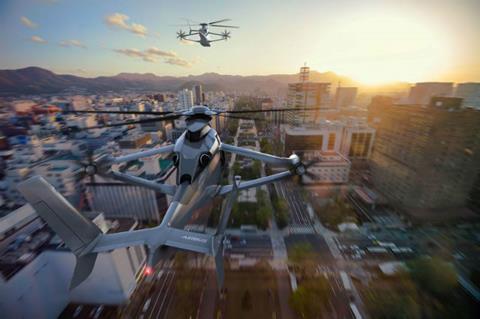Airbus Helicopters has detailed fresh progress on its Racer high-speed demonstrator as the airframer pushes to meet a first flight target now set for the end of 2022.
While the date for the maiden sortie appears to have slipped again – it was previously scheduled for early in the second half of next year – major structural parts are now being shipped to the manufacturer’s Marignane final assembly line in the south of France.

Speaking at the Royal Aeronautical Society’s annual European Rotorcraft Forum event on 7 September, Tomasz Krysinski, vice-president of research and innovation at Airbus Helicopters, said the completed main fuselage had been delivered to Marignane “two weeks ago”.
This was shipped from its facility at Donauworth in Germany which had joined and equipped the centre fuselage and nose sections.
In addition, Airbus Helicopters has received the Racer’s landing gear and the first of its twin Safran Aneto-1X engines, says Krysinski. “All the pieces are coming together,” he says.
A paper presented separately at the same conference by a team drawn from the airframer and wing supplier Hamble Aerostructures notes that “almost all of the main structural components [had been] manufactured” by June this year. At that point, the wings and tail parts were also “in final assembly” and are due to be shipped to the final assembly line “in the second half of 2021”.
Krysinski expects that by year-end the majority of components will have been received at Marignane, allowing ground tests to start by mid-2022, paving the way for first flight later that year.
Airbus Helicopters does not plan rig tests of the entire helicopter, instead the company or suppliers will perform full-scale load limit tests for certain key components such as the main fuselage mechanical deck, stub wings, wings, and tail and empennage. These are due to get under way in late 2021, the paper reveals.
Developed as part of the EU-funded Clean Sky 2 programme, the Racer’s compound architecture builds on the airframer’s earlier X3 design, incorporating twin pusher propellers mounted on the tips of the V-shaped “joined wings”, with the upper and lower wing surfaces configued in a “staggered” arrangement.

In high-speed forward flight, the main rotor is slowed and unloaded and effectively acts as a wing, providing around 50% of the required lift, with the V-wings supplying the remainder.
Anti-torque control comes from the lateral propellers in the hover, while at higher speeds this is “passively generated” by the H-shaped vertical tail, the paper says. These feature a unique “double kinked” layout thanks to the canting and sweep of the upper and lower vertical fins.
Additionally, the tail boom is asymmetric; one side is cambered and uses the downwash from the main rotor to generate an anti-torque contribution, increasing hover flight efficiency by about 10%, the presentation points out.
Krysinski says the Racer is “a very simple solution” which is “not more complicated than a normal helicopter” and will achieve its high-speed cruise target of 220kt (407km/h) in a “very cost-efficient way”.
Drag has been reduced by 45% over a conventional helicopter of the same size, he says, with the contra-rotating pusher configuration also contributing to the overall efficiency.
On top of that, one of the two Aneto-1X engines is capable of being idled in the cruise phase, contributing a 15% fuel-burn reduction, while still capable of flying at 180kt. Krysinski points out that a single engine operating at full power is more efficient than two powerplants running at 50%. A high-voltage electrical system will be used to rapidly restart the idled engine.
Maximum take-off weight for the Racer is in the 7-8t range, with a cabin size similar to that of the 8-10-passenger H145 light-twin.


























